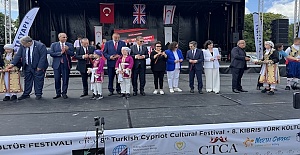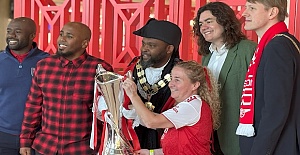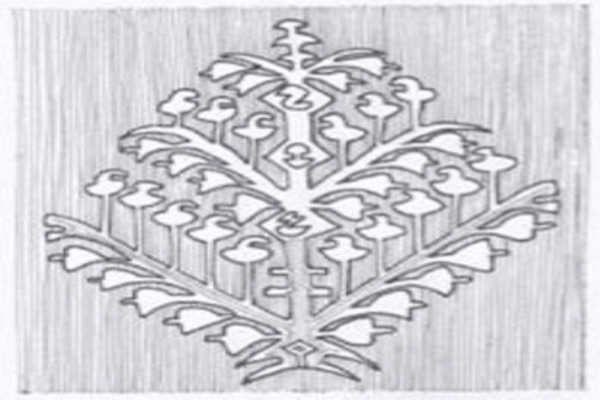By Muazzez İlmiye Çığ-In the olden days, before the Turks of the Central Asian steppes started migrating towards the West and converted to monotheistic religions, they worshipped Nature. The Sun was the focus of the veneration. Accordingly, they envisioned a sacred tree they named the “Tree-of-Life” arising from the Center of the Earth, whose tip reached all the way up to God Ulgen’s palace in the sky. The symbol of this “Tree-of-Life” is one of the key motifs found in all the hand made Turkish cut pile and flat woven (Kilim) rugs.
God Ulgen was the protector of mankind. He wore a long beard and a cloak. From his palace in the sky, he presided over the nights, the days and the sun. On December 21, the Winter solstice, herald the lengthening of the days and the shortening of the nights. The Sunrise was considered a new birth. The Turks thanked God Ulgen with a grand celebration called “Nardugan”* also called the “Pine Tree Festivals.”
A pine tree called “Akçam” indigenous to Central Asia, was the center of attraction of the Nardugan festivities. In order for the prayers to reach God Ulgen, this tree was meticulously decorated with ribbons tied on its branches. Each ribbon represented a wish made for the forthcoming year. As a token of gratitude for making their last year’s wishes come true and for the Sun rising once again to light the Earth for longer hours, the Turks thanked God Ulgen with presents they placed under the tree.
To observe the Nardugan, people cleaned their houses and wore their best cloths. They danced and sang around the tree. Elderly friends and relatives were visited. Families got together. They drank and ate special meals. Fresh and dried fruits and a candy like sweet dessert were the musts of Nardugan. They believed that celebrating this occasion with family and close friends would lengthen their lives and bring them good luck.
Undoubtedly, these customs and traditions were brought to the West by the Huns (A Turkic tribe) of the Central Asian steppes when they invaded Europe. The Romans, adopted the celebration of the Winter solstice and the lengthening of the days which according to the Julian calendar took place on December 25.
First, the early Christians continued with the pagan rituals of celebrating the solstice. Few centuries later, the celebration of solstice was substituted for the birth of Christ who, according to the Bible, was the “Light of the Universe.” The Roman Catholic Church chose December 25 as the day for the celebrations whereas the Eastern Church, under the reign of Constantin (324–337) with the first Ecumenical Council in Nicea (Iznik, Turkiye) adopted December 24 as the date for the celebration of the nativity.
However, by general consensus it has been agreed that Christ was born sometime in Autumn and not in December. As for the Christmas tree tradition, no pine tree grows in the land where Jesus was born. It seems, a Turkic ancestral tradition and belief have formed the basis of Christmas and its most famous symbol, the Christmas tree. The earliest known records of Christmas tree decorations date back to 1605 in Germany, from where it spread to France. Over the centuries, because of its pagan origins, there have been numerous objections by Christians to decorated Christmas trees. Would its Turkic origins as the celebration of life, make it unanimously acceptable to all faiths? Amen.
*Nar = Sun; Dugan (Tugan) = Being born, i.e., Sunrise)
Sources:
Murat Adji, Asia’s Europe, Volume I (Europe, Turki, the Great Steppe)
Adnan Atabek, Azerbaijan, Aref Esmailinia, İran
By Muazzez İlmiye Çığ


 CTCA UK Condemns the Political Forcing Out of Afzal Khan MP for Engaging with Turkish Cypriots
CTCA UK Condemns the Political Forcing Out of Afzal Khan MP for Engaging with Turkish Cypriots Tatar: “Reaction to MP’s TRNC visit is yet another stark example of the Greek Cypriot leadership’s primitive and domineering mentality”
Tatar: “Reaction to MP’s TRNC visit is yet another stark example of the Greek Cypriot leadership’s primitive and domineering mentality” Margaret Greer has been sworn in as the new Mayor of Enfield
Margaret Greer has been sworn in as the new Mayor of Enfield Prime Minister Keir Starmer's 2025 Easter message
Prime Minister Keir Starmer's 2025 Easter message Team Enfield ranks fifteenth the in London Youth Games
Team Enfield ranks fifteenth the in London Youth Games Parking enforcement boosted with more officers on patrol in Enfield
Parking enforcement boosted with more officers on patrol in Enfield Ersin Tatar meets with President Erdoğan
Ersin Tatar meets with President Erdoğan President Ersin Tatar Holds Ministerial-Level Meeting with UK Minister for Europe
President Ersin Tatar Holds Ministerial-Level Meeting with UK Minister for Europe UEFA Europa League and UEFA Conference League draws to be combined into one single show
UEFA Europa League and UEFA Conference League draws to be combined into one single show EuroLeague schedule for 2025-26 season announced
EuroLeague schedule for 2025-26 season announced Zeynep Sonmez becomes first Turkish tennis player to reach third round at Wimbledon
Zeynep Sonmez becomes first Turkish tennis player to reach third round at Wimbledon European champions Arsenal Women will play all of their league matches at the Emirates Stadium
European champions Arsenal Women will play all of their league matches at the Emirates Stadium Enfield Labour welcomes the completion of A10 average speed cameras extension.
Enfield Labour welcomes the completion of A10 average speed cameras extension. TfL opens 2025 grants for community groups to encourage more walking, cycling and active travel in the capital
TfL opens 2025 grants for community groups to encourage more walking, cycling and active travel in the capital Fethiye Launches International Digital Tourism Campaign with UK-Based Publisher
Fethiye Launches International Digital Tourism Campaign with UK-Based Publisher Highlights from the 3rd Trans-Caspian Connectivity Conference in London
Highlights from the 3rd Trans-Caspian Connectivity Conference in London

















